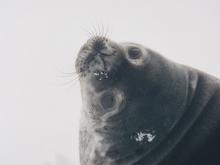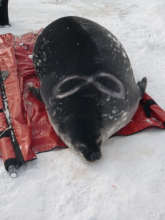Polar Gigantism in Antarctica
What Are They Doing?
 A Weddell seal meets a cameraman under the sea ice near McMurdo Station, Antarctica. Photo by Steve Rupp, Courtesy of Michael League.
A Weddell seal meets a cameraman under the sea ice near McMurdo Station, Antarctica. Photo by Steve Rupp, Courtesy of Michael League.
Since the first expeditions to the poles, scientists have compiled a long list of polar taxa that have unusually large body sizes. This phenomenon is known as polar gigantism, and biologists have proposed many hypotheses to explain it. The most broadly-accepted idea is the ‘oxygen hypothesis,’ which states that polar gigantism stems from a combination of high oxygen availability in the ocean and low metabolic rates because of the extreme cold temperatures. In combination, these two factors are thought to allow animals to be giants by making it comparatively easy to get enough oxygen from the environment to support large bodies. The links between body size, environmental oxygen availability, and performance have been used to argue that as marine and aquatic environments warm, giants will be among the first to disappear. We are looking at these tradeoffs and the validity of the size-vulnerability hypothesis using Antarctic pycnogonids (sea spiders), which contain spectacular examples of polar gigantism. Visit the researcher's working group website to learn more information on this topic.










